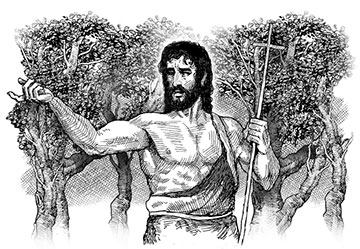Django

The movie opens with an iconic image — a drifter who moves around dragging a coffin. He chances upon a group of bandits about to execute a young woman and, being a gunslinger and quick on the draw, rescues her.
It is the eyes of the man, Django (played by Franco Nero), that catch the viewer’s attention. The camera zooms in on them and splashes their fire on the screen, alerting the viewer to what will ensue — justice growing out like a flower from the barrel of his gun.
In Raphael’s work, “St. John the Baptist in the Desert,” an oil painting done circa 1518 and now displayed at the Galleria degli Uffizi in Florence, Italy, we see Django’s eyes.
The eyes of John the Baptist in Raphael’s painting at the Uffizi are stern, as befits a man who called himself “a voice crying in the wilderness” and preached repentance. Django has the same unyielding stare, although it is the stare of one bent upon squaring up to people who have injured his family.
Sometimes I wonder if in his painting Raphael should not have given John a more flinty countenance, much like that of Franco Nero, who played Django’s role. After all, Nero was only 25 when the movie was made, and already he had the rugged physiognomy of a prophet. John the Baptist was thirty-ish, about the age of Jesus, when he made his first appearance in the Gospels. Instead, Raphael portrayed John the Baptist as a handsome, smooth-skinned youth, which, to be fair, was likewise how the others, for instance, Caravaggio and Leonardo da Vinci, represented him, often embedding in the image their own private, enigmatic message. Not only that, while the Gospels tell us that John the Baptist wore a shirt of camel skin and was girded with a leather belt, in the work of these artists he appears almost naked, the only cover around him is the carelessly draped shawl of a fashion model. We know that he is John the Baptist because of the attendance of the artistic conventions about him at the time — the presence of a bowl and a reed cross, and a finger pointed towards heaven.
A man with the physical characteristics of Django would have fitted the bill. Of John, Jesus said, “What did you go out into the wilderness to behold? A reed shaken by the wind? Why then did you go out? To see a man clothed in soft raiment? Behold those who wear soft raiment are in kings’ houses. Why then did you go out? To see a prophet? Yes, I tell you, and more than a prophet. This is he of whom it is written, ‘Behold, I send my messenger before thy face, who shall prepare thy way before thee.’”
Then Jesus gave John a compliment, that which no one can receive a greater on earth — “Truly, I say to you, among those born of women there has risen no one greater than John the Baptist.” Nevertheless, Jesus added, “Yet he who is least in the kingdom of heaven is greater than he.”
I think that it is in acknowledgment of this that, in the paintings of the Renaissance artists, John points a finger to heaven.
Sergio Corbucci leaned towards symbolism. The film ends with evocations of Christ, although on an altogether different level. Here, Corbucci pushed the spiritual to as far as a spaghetti Western could go. In a cemetery, as his arch-enemy approaches, Django, his hands crushed and bloodied, stays behind a cross, in which, in a way, he finds salvation — by pressing against it the trigger of his pistol, from which he had bitten off the guard. After he kills his enemy, he rises from his crouch on a grave and leaves the cemetery.
In Raphael’s painting, John uses the same finger, which a gunman like Django would use to pull the trigger, to point to the cross on top of a reed.
Somehow, all this the writer Joshua Harris summarizes — “The world takes us to a silver screen on which flickering images of passion and romance play, and as we watch, the world says, ‘This is love.’ God takes us to the foot of a tree on which a naked and bloodied man hangs and says, ‘This is love.’”